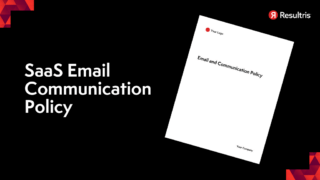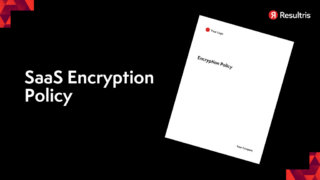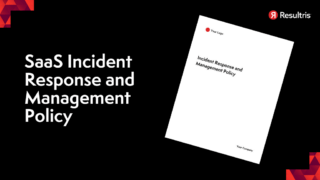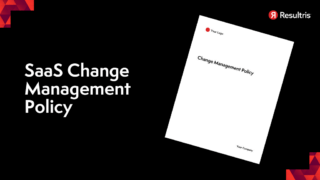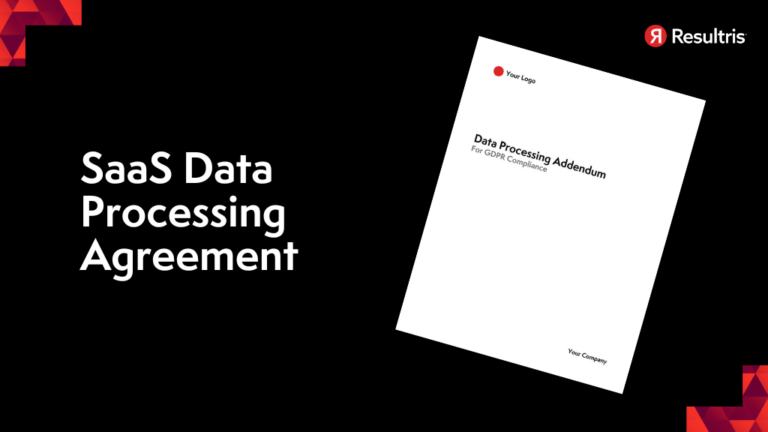
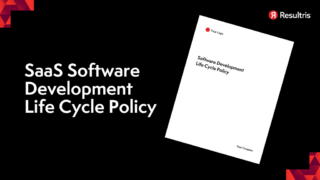
Written by: Tim Eisenhauer
Last updated:

In the digital age, where data is the new oil, understanding the intricacies of a SaaS Data Processing Agreement can be a game-changer. This agreement, often overlooked, is a critical component in the SaaS ecosystem, governing how your valuable data is handled, stored, and protected.
As you navigate the SaaS landscape, it’s vital to recognize the significance of these agreements. They’re not just legal jargon but a roadmap to SaaS Compliance and Security Best Practices.
In this article, we’ll dive into the world of SaaS Data Processing Agreements, helping you understand its importance, what to look for, and how it impacts your business. So, buckle up and get ready to become a more informed SaaS user.
To extend your SaaS know-how, let’s delve into Data Processing Agreements (DPAs) and their core concepts.
A DPA, formally known as a Data Processing Agreement, encapsulates an authoritative contract. It governs data management between two entities: data controllers and data processors. In a SaaS DPA context, SaaS providers bear the mantle of processors, while businesses using the SaaS service are controllers.
Primarily, a DPA outlines responsibilities and boundaries concerning data handling and protection. It specifies how data is processed, who gets access, the extent of processing, and the means of ensuring data safety. Think of a DPA as the rulebook for data processing in the SaaS ecosystem.
DPAs aren’t an optional part of the SaaS world—they’re mandatory. Notably under the EU General Data Protection Regulation (GDPR), having a precise and methodical DPA isn’t just an encouraging rule—it’s the law! GDPR data processing necessitates feasible and transparent DPAs, irrespective of the business size or industry.
You, as a SaaS user or provider, need a DPA not only to meet legal requirements but also to protect your business from potential data mishandling claims and complications.
SaaS DPAs serve as a principal risk mitigation tool for any company. How? By stipulating clear conditions and roles for data handling, preventing data breaches becomes plausible. In the event of a breach, a well-defined DPA helps allocate responsibility, consequently preventing blame shifting. In essence, it provides a practiced norm for managing and protecting data, ultimately aiding risk mitigation.
SaaS companies thrive on trust, especially when it involves customers’ data. Your DPA isn’t just another document—it’s a promise to your clientele. It expresses your commitment to safeguard their data, respecting their privacy, and conforming to benchmark security procedures. Providing a comprehensive data processing agreement elevates the integrity of any SaaS offering, establishing transparency, fostering customer trust, and fortifying customer relationships.
With a cloud service agreement sincerely committing to data protection, your journey in the SaaS world becomes smoother and less problematic. So, have you taken a close look at your SaaS DPA today? Would it stand up to scrutiny?
In the context of SaaS data processing, a booming field, it’s crucial to grasp the regulatory landscape governing it. To fully comprehend this landscape, it’s imperative to delve into GDPR mandates and various other prominent regulations.
GDPR paves the way for stringent data protection throughout European nations and impacts businesses worldwide. At its core, GDPR mandates a robust Data Processing Agreement (DPA) between parties handling personal data. Compliance with GDPR isn’t optional, it’s a legal mandate for businesses functioning within its jurisdiction or for those handling data of EU residents. Uncompromised adherence to GDPR data processing requirements would go a long way in elevating your business to high data protection standards, avoiding substantial financial penalties, and escalating trust in your SaaS offerings.
As we venture further down the rabbit hole of data legislation, we encounter several other crucial data protection laws.
CCPA, the keystone data privacy law in the US, governs personal data usage akin to GDPR. CCPA comes into effect when businesses in California or those dealing with Californians’ data reach certain thresholds. Comprehending and implementing CCPA in your SaaS DPA can help build a strong data protection framework. Addition of other state-specific laws onto this framework provides a broad defense against privacy-related legal hurdles.
When carrying out data protection, keep in mind industry-specific regulations such as HIPAA for healthcare and PCI-DSS for payments. These regulations mandate strict adherence and specify requirements for a robust data processing agreement. Integrating these with your SaaS DPA can assist you in navigating industry-specific data challenges, ensuring your cloud service agreement checks all necessary regulatory boxes.
Aligned with regulations, a well-structured SaaS DPA, balancing both user privacy and business interests, pays off in the long run. It not only fortifies data protection but also builds trust and credibility.
The core of a SaaS Data Processing Agreement (DPA) lies in its components. These elements shape the contract, addressing key aspects of data protection and compliance in the SaaS environment.
A successful DPA is clear on the parties involved and their assigned duties. These roles include the Data Controller and the Data Processor, with the possibility of also involving sub-processors.
In terms of a SaaS DPA, the Data Controller is typically the SaaS user, and the Data Processor, the SaaS provider. The Data Controller determines the reasons and means for processing personal data, while the Data Processor processes data based on the controller’s instructions.
Sub-processors are third parties engaged by the Data Processor to further process personal data. The terms regarding their management such as their approval, obligations, and liabilities should be clearly stated in the SaaS DPA.
It’s crucial to outline the specifics of data processing within the SaaS DPA. This includes identifying the data types and the permitted processing activities.
The agreement must specify the categories of data being processed. This could range from basic user information, billing details, to more sensitive data such as health or financial records.
How the data can be used and the purpose of its use should also be delineated in the agreement. This aids in maintaining GDPR data processing compliance and protecting user’s rights.
To ensure robust data handling, the DPA must enforce both technical and organizational steps of security.
Technical safeguards are the measures taken by the processor to protect data from breaches, encompassing encryption, access controls, and regular security testing.
Organizational measures relate to the policies and procedures established by the processor to ensure GDPR compliant data processing. These include personnel training, clear documentation of processing activities, and implementing a data breach response plan.
Lastly, the DPA must establish the business’s responsibility in handling data subject requests and assist the controller in maintaining compliance.
The agreement should elucidate how data subjects can exercise their rights, including requests for data access, rectification, erasure, and data portability.
A competent DPA empowers the controller in fulfilling their GDPR obligations. This includes notifying the controller promptly regarding any data breach and assisting them in carrying out Data Protection Impact Assessments, if required.
Understanding and implementing these key components in a SaaS DPA helps maintain strong compliance with data protection regulations like GDPR. It ensures consistently high standards in data handling, fostering customer trust in your SaaS applications.
Crafting a meticulous SaaS Data Processing Agreement (DPA) plays a critical role in regulating the relationship between your SaaS platform and your customers – particularly in the realm of data protection. After understanding the core components of a DPA in our previous section, let’s dig deeper into drafting such an agreement.
Incorporating certain clauses into your SaaS DPA is integral to its completion. Some fundamental clauses include:
While the components of a SaaS DPA remain relatively standard, different customers might have divergent needs. Say, a small business might focus on basic data requisites, while an enterprise might insist on advanced security features. Striking a balance between providing customization but maintaining legal rigor is the trick. Begin by identifying unique customer demands, then design DPAs accordingly. The more flexible your DPA, the broader customer base you cater to.
Drafting a data processing agreement isn’t an error-prone task. Remember to include all relevant aspects of your platform’s data handling. Legal oversights in the SaaS DPA could cost you hefty GDPR data processing fines or worse – loss of customer trust. Therefore, conduct a thorough review of your DPA, examining whether it aligns with data protection regulations like CCPA, HIPAA, and PCI-DSS. Consider getting it evaluated by a legal expert in your industry. Their insights could save you from any avoidable missteps.
And there you have it: the groundwork for a sound SaaS Data Processing Agreement. Remember, your DPA isn’t just a cloud service agreement; it’s a testament to how your data protection contract safeguards your customers’ precious data.
Executing SaaS Data Processing Agreements (DPAs) effectively entails intricate and cohesive strategies. The task isn’t merely signature and storage; it’s embedding the contractual terms into your operational core and ensuring everything aligns with GDPR data processing rules and other relevant regulations. Leverage a well-articulated DPA to bolster your business’s data protection protocol.
DPAs sit at the crossroads of sales and compliance. Align your SaaS DPA with the sales process to usher in smooth transactions and imperative data protection. Conduct critical discussions with potential clients about data processing right off the bat, bolstering their confidence in your services. Use the DPA as a tool in negotiations, demonstrating your commitment to state-of-the-art data management and security measures, in line with GDPR and other regulatory bodies.
Your cloud service agreement, ideally, should incorporate the DPA, taking privilege in its importance rather than treating it as an afterthought. Your sales team must have a comprehensive understanding of your data protection contract to address prospective customer queries effectively. Enhanced clarity around the DPA in your sales process not only meets legislative requirements but also enables you to stand out in the SaaS marketplace.
DPAs aren’t isolated to the legal or sales department; they permeate throughout your organization. Employee training plays a pivotal role in internal DPA compliance. Regular training sessions can equip your team to understand and adhere to data processing terms. Topics covered can include types of data processed, the purpose of processing, data subject rights, and essential security measures.
Harness scenarios and examples within these training sessions. For instance, customer service representatives might be trained on how to handle data subject access requests, while developers could be educated on keeping personal data protection top-of-mind when creating new features. It’s not just about understanding the “what” but also the “why” behind processing terms.
Logs and records substantially streamline your auditing and compliance process. Maintain detailed records of your processing activities, documenting everything from the data type collected to the purpose of processing and storage. GDPR requires this practice, ensuring transparency and accountability.
In the course of inspection or breach, these records provide an auditable trail, reaffirming your commitment to stringent data protection measures. This proactive approach helps safeguard against potential non-compliance penalties and aids in swiftly responding to data subject requests.
Implementing DPAs effectively necessitates a comprehensive, company-wide effort. When appropriately executed, a robust DPA doesn’t merely satisfy regulatory requirements, but augments trust and transparency with your customers, a critical competitive element in the SaaS landscape.
Beyond adherence to standard compliance and embedding contractual terms, managing sub-processors in SaaS environments presents additional challenges. A deep understanding of their roles and obligations plays a vital role in securing your data.
Vetting sub-processors proves essential in maintaining a robust SaaS data processing agreement (DPA). This process involves extensive due diligence. It’s vital to assess the sub-processor’s GDPR data processing strategies, data protection policies, and technical safeguards. For instance, consider their encryption technology, access controls, and security incident management systems. These aspects indicate whether a sub-processor can abide by the strict controls stipulated in a cloud service agreement.
Establishing definitive contractual obligations forms the backbone of a reliable data protection contract. These contracts should clearly define the responsibilities and rights of each party involved. Critical terms and conditions include the purpose and duration of data processing, the nature and categories of data processed, and the rights of data subjects. Also, it’s necessary to ensure these contracts impose equivalent GDPR data processing obligations on sub-processors.
Transparency fuels customer trust in managing SaaS DPA. Consequently, companies should keep customers updated on any changes to sub-processors. This includes notifying customers of intended changes, giving them the opportunity to object if they deem it necessary. Such provisions not only align with GDPR’s core principle of transparency, but they also foster long-term relationships with clients by reinforcing their role in the data processing equation.
Let’s delve into the maze of data transfer considerations associated with a SaaS Data Processing Agreement (DPA). This segregation brings to light international transfers and data localization stipulations.
Intricacies of international data transfers can pose significant challenges.
Post-Schrems II scenario foisted a significant change in the EU-US data transfer narrative. Previously, it was Privacy Shield that provided a framework for exchanges of personal data for commercial purposes. Within the bounds of a SaaS DPA, this ruling necessitated a re-evaluation of data handling mechanisms, ascertaining the configuration is in consonance with GDPR data processing norms.
Standard Contractual Clauses or SCCs constitute an alternate pullout for trans-Atlantic data transfer. Precisely, clauses safeguard data, acting as a bridging mechanism in a cloud service agreement. In theory, SCCs must guarantee GDPR compliance. However, pertaining to the intricacies of the SaaS DPA, it remains essential that businesses remain mindful of the SCCs’ geographic scope and possible limitations.
Data localization requirements further complicate the data protection contract. Certain jurisdictions make it mandatory for companies to store and process data within their geographical bounds. Under such requirements, businesses might need to establish local data centers or rely on local cloud services – an added complexity to managing a SaaS DPA. Thus, it remains vital to comprehend the concerning regulations, ensuring your approach to data handling aligns with every regional law in question.
In any SaaS DPA, addressing data breaches asserts paramount importance. It’s a process that comprises notifying the authorities, cooperating with the data controllers, and fulfilling the documentation and reporting requirements. Let’s delve into these key areas.
In a data processing agreement, a crucial component includes being ready for a data breach. GDPR data processing necessitates that SaaS DPAs provide clear notification policies. For instance, within 72 hours of a breach, notifications must be sent to the concerned authority. This adherence to stipulated timeframes displays accountability and commitment to data protection.
A SaaS DPA often mandates cooperation with data controllers. It’s crucial since the data controllers own the data that is being processed. In the event of a data breach, you’d need to work closely with the data controllers to mitigate the impact, identifying the compromised data and implementing necessary corrective measures. Your cloud service agreement might also require you to assist data controllers in fulfilling their data protection obligations under the law.
Finally, remember that a data protection contract requires thorough documentation and compliance with reporting standards. In the aftermath of a data breach, it’s essential to record the details, evaluate the extent of the impact, and assess the effectiveness of your response. A proper report of a data breach not only displays action taken but also highlights areas for improvement to prevent future occurrences.
Navigating a data breach under a DPA can appear daunting. However, with well-established procedures, cooperation with data controllers, and robust documentation, the process becomes streamlined and manageable.
Auditing and compliance maintain an indispensable role in implementing an effective SaaS Data Processing Agreement (DPA). This section imparts essential knowledge on customer audit rights, reliance on third-party certifications like ISO 27001, SOC 2, and beyond, as well as demonstrating compliance with DPA terms.
In relation to a SaaS DPA, you’ve a legal right to examine your cloud service provider’s data processing operations. This right facilitates transparency and aids in ensuring your vendors process your data in adherence to agreed norms. For example, a company might decide to audit its cloud service provider to validate the effectiveness of their data protection measures.
Third-party certifications serve as evidence of a company’s commitment to maintaining information security standards. Certifications like ISO 27001, SOC 2, among others, reflect an organization’s dedication to GDPR data processing, providing a sense of assurance to customers. For instance, the ISO 27001 certification, signifies that a company has established a robust Information Security Management System (ISMS).
Manifesting compliance with DPA terms isn’t solely about adherence. It’s about demonstrating and documenting that commitment, providing evidence at every possible avenue. For instance, a firm might document their data protection protocols and any modifications made during the agreement duration, updating their customers regularly to demonstrate compliance. Remember, consistent compliance helps foster trust, a vital component in enhancing the robustness of your SaaS DPA.
In SaaS Data Processing Agreements (DPAs), transparency surrounding termination and data deletion is essential. This section presents critical details about the end of service procedures, data portability and return, and secure data deletion practices.
Upon concluding a cloud service agreement, it’s crucial to outline well-defined end of service procedures. Such procedures ensure an orderly and secure termination of the SaaS DPA, without leaving any loose ends. These procedures typically cover aspects like final payments, obligations for data return, notifications for end of service, and details about data deletion after contract dissolution.
Data portability and return are significant aspects of a GDPR data processing agreement. Following service termination, customers possess the right to retrieve their data securely and efficiently. Establishing clear protocols for data retrieval, including data formats and transfer methods, assures smooth transitions. It’s also paramount to define timelines for data return post-termination, thus aligning with best practices, and regional and industry-specific compliance regulations.
Upon contract conclusion, secure data deletion practices play a crucial role in fulfilling a data protection contract’s obligations. Procedures must ensure complete data removal from the company’s records, backups, and any third-party subcontractors involved in the processing. Established practices, such as overwriting, degaussing, and physical destruction, may be relevant depending on the data format. Disclosure of these practices to customers adds layers of trust and transparency to the overall SaaS DPA.
The world of Data Processing Agreements (DPAs) ever-evolves, introducing new considerations that range from AI and Machine Learning to Edge Computing and Blockchain. This evolution impacts both GDPR data processing and cloud service agreements. As a business owner, it’s crucial to stay updated and understand these trends.
AI and Machine Learning present new challenges and opportunities for DPAs. For instance, AI algorithms require vast amounts of data, pushing the boundaries of your current SaaS DPA. Effectively managing this data under GDPR rules isn’t just a good practice—it’s a legal necessity. The use of AI and Machine Learning entails closer scrutiny of data collection, storage, and processing practices. This development makes constant auditing, transparency in algorithm operations, and understanding AI-induced disclosures vital in a DPA.
The rise of edge computing and the Internet of Things (IoT) also influence data processing contracts. Data in these technologies is processed closer to the source, posing security and privacy challenges. Thus, your SaaS DPA must cover aspects like data localization, security measures, and data breach protocols for edge devices and IoT networks. Understand that the unique characteristics and vulnerabilities of these technologies require a DPA that can handle the added complexity.
Lastly, decentralized data processing via blockchain presents a fascinating shift in how we look at data protection contracts. Blockchain technology is creating decentralized DPAs where data isn’t managed by a single party but a network of peers. The increased level of transparency and security is a boon, but the decentralized nature complicates the traditional notion of responsibility in data processing. Consequently, crafting a DPA becomes a delicate balancing act—honoring the nuances of the technology while maintaining adherence to GDPR and other compliance obligations.
Navigating this evolving landscape can be challenging, but it’s essential for maintaining a robust, compliant SaaS DPA. So, keep up, adapt, remain vigilant—and stay ahead in the game.
As you navigate the SaaS landscape, understanding and implementing best practices for Data Processing Agreement (DPA) management becomes critical. These best practices emphasize the importance of streamlining negotiations, regular reviews, updates, and fostering a culture of data protection.
Begin by approaching DPA negotiations strategically. That means understanding your data processing needs and having a clear perspective of what you are looking for in a DPA. A well-prepared negotiation strategy makes the process faster, smoother, and ensures that both parties are on the same page when it comes to processing and protecting data. Additionally, using standardized contractual clauses, where appropriate, speeds up the negotiation process. They serve as a benchmark, a kind of a template, for your SaaS DPA.
Next, regular review and updating of your DPAs are vital. Keep in mind, the regulatory environment around data protection and privacy changes frequently. For instance, the introduction of GDPR data processing norms, among others, brought major shifts in data protection requirements. Regular updates of your DPAs with cloud service providers ensure you continue to comply with such changes and maintain data security and privacy.
Lastly, cultivating a culture of data protection across your organization is an essential best practice. Recognize, ensuring data protection isn’t merely a legal obligation but a commitment to the privacy of your customers, clients, employees. It instills trust and enhances your business reputation. Therefore, include data protection in your training programs, encourage employees to attend seminars or webinars on the importance of data security, regularly update personnel about changes in DPA requirements. This way, everyone becomes a contributing factor to securing your SaaS DPA and, eventually, your business’s data.
So, you’ve seen the importance of SaaS Data Processing Agreements and how they’re key to ensuring data security and regulatory compliance. You’ve learned about the various components of DPAs, from managing sub-processors to handling data breaches. You’ve also delved into best practices for managing your DPAs effectively, such as conducting regular reviews and fostering a culture of data protection. It’s clear that staying updated with evolving trends like AI, Machine Learning, and Blockchain is crucial to maintaining robust and compliant DPAs. Remember, it’s all about understanding your data processing needs, using standardized contractual clauses, and keeping up with regulatory changes. By doing so, you’re not just complying with the law but also safeguarding your business in today’s rapidly changing technological landscape.
Disclaimer
Please note that the information provided in this blog post is for informational purposes only and does not constitute legal advice. We are not lawyers, and reading this content does not create an attorney-client relationship. For legal advice specific to your situation, please consult with a qualified attorney.

